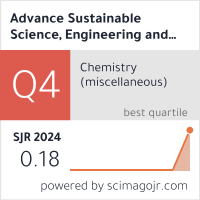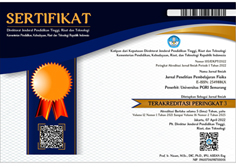Fuzzy Logic-Based Clustering of Teacher Digital Pedagogy Using Cybergogy Framework for Sustainable Educational Innovation
DOI:
https://doi.org/10.26877/asset.v7i3.1946Keywords:
Cybergogy, Fuzzy C-Means, PCA, Digital Pedagogy, Teacher ProfilingAbstract
Rapid changes in educational technology necessitate innovative approaches to sustainable teacher development. However, implementing learning technologies like Cybergogy faces significant challenges due to imbalances in digital pedagogy competencies and motivation among secondary school mathematics teachers. This study aims to cluster mathematics teachers' profiles based on the Cybergogy model's application using the Fuzzy C-Means (FCM) algorithm. The study involved 88 mathematics teachers from various secondary schools in Yogyakarta, Indonesia. Clustering results converged at the sixth iteration with an objective function value of 620.006, and an optimal two-cluster structure (PCI = 0.5578). Cluster 1 comprises teachers with high digital competencies and effective use of online learning media in understanding Cybergogy. Conversely, Cluster 2 includes teachers with limited online learning experience and low Cybergogy understanding. These findings highlight the lack of appropriate training efforts to support technology implementation and motivate each cluster based on their unique perceptions of Cybergogy. This study contributes to educational technology by offering insights into how the Cybergogy model can enhance digital learning quality, with long-term implications for teacher competency development and the sustainability of digital education innovation in Indonesia.
References
[1] Wang M, Kang M. Cybergogy for engaged learning: A framework for creating learner engagement through information and communication technology. Engaged Learning with Emerging Technologies, Springer; 2006, p. 225–53. https://doi.org/10.1007/1-4020-3669-8_11.
[2] United Nations. Transforming Our World: The 2030 Agenda for Sustainable Development. New York: United Nations; 2015.
[3] Garrison DR. Communities of Inquiry in Online Learning. Encyclopedia of Distance Learning, Second Edition, IGI Global; 2011, p. 352–5. https://doi.org/10.4018/978-1-60566-198-8.ch052.
[4] OECD. Education at a Glance 2020: OECD Indicators. OECD Publishing; 2020. https://doi.org/10.1787/69096873-en.
[5] Harasim L. Learning Theory and Online Technologie. Second Edi. New York: Routledge; 2017. https://doi.org/https://doi.org/10.4324/9781315716831.
[6] Sharma R, Tan C, Gomez D, Xu C, Dubé AK. Guiding teachers’ game-based learning: How user experience of a digital curriculum guide impacts teachers’ self-efficacy and acceptance of educational games. Teach Teach Educ 2025;155. https://doi.org/10.1016/j.tate.2024.104915.
[7] Mailizar, Almanthari A, Maulina S, Bruce S. Secondary school mathematics teachers’ views on e-learning implementation barriers during the COVID-19 pandemic: The case of Indonesia. Eurasia Journal of Mathematics, Science and Technology Education 2020;16. https://doi.org/10.29333/EJMSTE/8240.
[8] Tondeur J, van Braak J, Ertmer PA, Ottenbreit-Leftwich A. Understanding the relationship between teachers’ pedagogical beliefs and technology use in education: a systematic review of qualitative evidence. Educational Technology Research and Development 2017;65:555–75. https://doi.org/10.1007/s11423-016-9481-2.
[9] Thurm D, Barzel B. Effects of a professional development program for teaching mathematics with technology on teachers’ beliefs, self-efficacy and practices. ZDM - Mathematics Education 2020;52:1411–22. https://doi.org/10.1007/s11858-020-01158-6.
[10] Drijvers P, Sinclair N. The role of digital technologies in mathematics education: purposes and perspectives. ZDM - Mathematics Education 2024;56:239–48. https://doi.org/10.1007/s11858-023-01535-x.
[11] Abdillah, Syaharuddin S, Mandailina V, Mehmood S. The Role of Mathematics in Machine Learning for Disease Prediction: An In-Depth Review in the Healthcare Domain. Advance Sustainable Science Engineering and Technology (ASSET) 2024;6:02404010. https://doi.org/10.26877/asset.v6i4.845.
[12] Hwang GJ, Chu HC, Yin C. Objectives, methodologies and research issues of learning analytics. Interactive Learning Environments 2017;25:143–6. https://doi.org/10.1080/10494820.2017.1287338.
[13] Peña-Ayala A. Educational data mining: A survey and a data mining-based analysis of recent works. Expert Syst Appl 2014;41:1432–62. https://doi.org/10.1016/j.eswa.2013.08.042.
[14] Wang Q, Liu L, Liu Z, Qiao W, Liu F. Application of Fuzzy Clustering in Higher Education General Management Based on Internet Environment. Math Probl Eng 2022;2022. https://doi.org/10.1155/2022/3438666.
[15] Kline RB. Principles and Practice of Structural Equation Modeling. vol. 1. Fourth Edi. New York: The Guilfprd Press; 2012. https://doi.org/10.15353/cgjsc-rcessc.v1i1.25.
[16] Shen J, Leslie JM, Spybrook JK, Ma X. Are Principal Background and School Processes Related to Teacher Job Satisfaction? A Multilevel Study Using Schools and Staffing Survey 2003-04. Am Educ Res J 2012;49:200–30. https://doi.org/10.3102/0002831211419949.
[17] Howard SK, Thompson K, Yang J, Ma J. Working the system: Development of a system model of technology integration to inform learning task design. British Journal of Educational Technology 2019;50:326–41. https://doi.org/10.1111/bjet.12560.
[18] Instefjord EJ, Elaine Munthe. Educating digitally competent teachers: A study of integration of professional digital competence in teacher education. Teach Teach Educ 2017;67:37–45. https://doi.org/https://doi.org/10.1016/j.tate.2017.05.016.
[19] Thurm D. Teacher Beliefs and Practice When Teaching with Technology: A Latent Profile Analysis. Uses of technology in primary and secondary mathematics education, Springer International Publishing; 2018, p. 409–19. https://doi.org/10.1007/978-3-319-76575-4_25.
[20] Prodromou T, Lavicza Z. Integrating technology into mathematics education in an entire educational system - Reaching a critical mass of teachers and schools. International Journal for Technology in Mathematics Education 2017;24:129–35. https://doi.org/10.1564/tme_v24.3.04.
[21] Semerci A, Aydın MK. Examining High School Teachers’ Attitudes towards ICT Use in Education. International Journal of Progressive Education 2018;14:93–105. https://doi.org/10.29329/ijpe.2018.139.7.
[22] Etikan I. Comparison of Convenience Sampling and Purposive Sampling. American Journal of Theoretical and Applied Statistics 2016;5:1. https://doi.org/10.11648/j.ajtas.20160501.11.
[23] Kim. Multicollinearity and misleading statistical results. Korean J Anesthesiol 2019;72:558–69.
[24] Islami RL, Sihombing PR. Application biplot and k-medians clustering to group export destination countries in Asia, Africa, America, and Europe of Indonesia’s product. Advance Sustainable Science, Engineering and Technology 2021;3. https://doi.org/10.26877/asset.v3i1.8451.
[25] Wang M, Kang M. Cybergogy for engaged learning: A framework for creating learner engagement through information and communication technology. Engaged Learning with Emerging Technologies, Springer; 2006, p. 225–53. https://doi.org/10.1007/1-4020-3669-8_11.
[26] Hathaway RJ, Bezdek JC. Recent convergence results for the fuzzy c-means clustering algorithms. J Classif 1988;5:237–47. https://doi.org/10.1007/BF01897166.
[27] Tilson L V., Excell PS, Green RJ. A generalisation of the Fuzzy c-Means clustering algorithm. Remote Sensing Proc IGARSS ’88 Symposium, Edinburgh, 1988 Vol 3 1988;10:1783–4. https://doi.org/10.1109/igarss.1988.569600.
[28] Chen X, Self JZ, House L, Wenskovitch J, Sun M, Wycoff N, et al. Be the Data: Embodied Visual Analytics. IEEE Transactions on Learning Technologies 2018;11:81–95. https://doi.org/10.1109/TLT.2017.2757481.
[29] Zhang L, Wang S, Liu B. Deep learning for sentiment analysis: A survey. Wiley Interdiscip Rev Data Min Knowl Discov 2018;8:1–25. https://doi.org/10.1002/widm.1253.
[30] Geron A. Hands-on Machine Learning with Scikit-Learn, Keras & TensorFlow. 2nd ed. Canada: O’Reilly Media, Inc; 2019.
[31] Rahayu S, Sugiarto T, Madu L, Holiawati H, Subagyo A. Application of Principal Component Analysis (PCA) to Reduce Multicollinearity Exchange Rate Currency of Some Countries in Asia Period 2004-2014. Int J Educ Method 2017;3:75–83. https://doi.org/10.12973/ijem.3.2.75.
[32] Jollife IT, Cadima J. Principal component analysis: A review and recent developments. Philosophical Transactions of the Royal Society A: Mathematical, Physical and Engineering Sciences 2016;374. https://doi.org/10.1098/rsta.2015.0202.
[33] de Jonge J. Multivariate Data Analysis (Sixth Edition). vol. 19. 2006. https://doi.org/10.5117/2006.019.003.007.
[34] Famalika A, Sihombing PR. Implementation of k-means and k-medians clustering in several countries based on Global Innovation Index (GII) 2018. Advance Sustainable Science, Engineering and Technology 2021;3. https://doi.org/10.26877/asset.v3i1.8461.
[35] De Andrade TL, Rigo SJ, Barbosa JLV. Active Methodology, Educational Data Mining and Learning Analytics: A Systematic Mapping Study. Informatics in Education 2021;20:171–204. https://doi.org/10.15388/infedu.2021.09.
[36] Susianti S, Muis H, Misrah, Akhbar, Arianingsih I, Baharuddin RF, et al. The Analysis of Habitat Suitability for Macaca Tonkeana in the Pangi Binangga Natural Reserve of West Toboli Village Using SIG and PCA Approach. Advance Sustainable Science, Engineering and Technology 2024;6. https://doi.org/10.26877/asset.v6i2.18798.
[37] Jollife IT, Cadima J. Principal component analysis: A review and recent developments. Philosophical Transactions of the Royal Society A: Mathematical, Physical and Engineering Sciences 2016;374. https://doi.org/10.1098/rsta.2015.0202.
[38] Zhao W, Song Y, Zhao Q, Zhang R. The effect of teacher support on primary school students’ reading engagement: the mediating role of reading interest and chinese academic self-concept. Educ Psychol (Lond) 2019;39:236–53. https://doi.org/10.1080/01443410.2018.1497146.
[39] Huang, R., Liu, D. J., Tlili, A., Yang, J., & Wang H. Handbook on facilitating flexible learning during educational disruption: The Chinese experience in maintaining undisrupted learning in COVID-19 outbreak. Beijing: Smart Learning Institute of Beijing Normal University. Beijing: Smart Learning Institute of Beijing Normal University 2020:46.
[40] Lim SC, Yiung SN, Isawasan P, Lee CK, Lim SP. Factors influencing teachers’ intention to adopt ICT into teaching using partial least square technique methods. AIP Conf Proc 2018;2016. https://doi.org/10.1063/1.5055478.
[41] Francisco-Ignacio R-Domínguez, Guerra-Antequera J, Gonzáles-Pérez A, Pedrera-Rodríguez MI, Gonzáles-Fernández A. Digital teaching competence: a literature review [Competencia digital docente: una revisión de la literatura]. Texto Livre 2022;15:1–15. https://doi.org/10.17605/OSF.IO/P5KTG.
[42] Huang R, Adarkwah MA, Liu M, Hu Y, Zhuang R, Chang T. Digital Pedagogy for Sustainable Education Transformation: Enhancing Learner-Centred Learning in the Digital Era. Frontiers of Digital Education 2024;1:279–94. https://doi.org/10.1007/s44366-024-0031-x.
[43] Vičič Krabonja M, Kustec S, Skrbinjek V, Aberšek B, Flogie A. Innovative Professional Learning Communities and Sustainable Education Practices through Digital Transformation. Sustainability (Switzerland) 2024;16. https://doi.org/10.3390/su16146250.
[44] Kalliomäki-Levanto T, Kivimäki I, Varje P, Haavisto O. Topic modeling and clustering in the trace data-driven analysis of job demands among teachers. Sci Rep 2023;13. https://doi.org/10.1038/s41598-023-45356-0.
[45] Hatlevik OE, Gudmundsdóttir GB, Loi M. Examining factors predicting students’ digital competence. Journal of Information Technology Education 2015;14:123–37. https://doi.org/10.28945/2126.
[46] Chigbu BI, Makapela SL. Data-Driven Leadership in Higher Education: Advancing Sustainable Development Goals and Inclusive Transformation. Sustainability (Switzerland) 2025;17. https://doi.org/10.3390/su17073116.
[47] Chahuán-Jiménez K, Lara-Yergues E, Garrido-Araya D, Salum-Alvarado E, Hurtado-Arenas P, Rubilar-Torrealba R. Cluster analysis of digital competencies among professors in higher education. Front Educ (Lausanne) 2025;10. https://doi.org/10.3389/feduc.2025.1499856.
[48] Dille KB, Røkenes FM. Teachers’ professional development in formal online communities: A scoping review. Teach Teach Educ 2021;105:103431. https://doi.org/10.1016/j.tate.2021.103431.
[49] Al-Awidi, H; Aldhafeeri F. Teachers’ readiness to implement digital. Journal of Information Technology Education:Research 2017;16:105–26.
[50] Trust T, Whalen J. Should Teachers be Trained in Emergency Remote Teaching? Lessons Learned from the COVID-19 Pandemic. Jl of Technology and Teacher Education 2020;28:189–99.
[51] Trust T, Whalen J, Mouza C. Editorial: ChatGPT: Challenges, Opportunities, and Implications for Teacher Education. Contemporary Issues in Technology and Teacher Education 2023;23:1–23.











